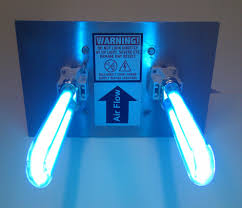Common Types Of Ultraviolet Disinfection (UV Lamps) for Chemical Free Water Disinfection

Types of Ultraviolet Disinfection (UV) Lamps for Chemical Free Water & Wastewater Treatment
When it comes to water and wastewater treatment systems, operational and performance variation will come from different components. This variance can come from the differences treatment processes deployed, whether chemicals are utilized or how much power the treatment processes require. With many treatment systems, there is much consideration given to a particular central component akin to the heart and soul of the treatment system. In the case of a UV system, the Ultraviolet (UV) lamps are this component.
A system of lamps is what generates the appropriate levels of UV light to eradicate the pathogenic content of the water to be treated. In general, ultraviolet (UV) lamps consist of some type of metallic filament that provides an electrical arc that excites mercury vapor. Exciting the vapor will cause it to heat up and increase pressure within the tube and give off UV radiation. For disinfection, the sub type of UVC is desired, but at that short wavelength, the light cannot pass through typical glass so a sleeve made of quartz makes up the main body of the lamp.
Quick Definitions:
Output: refers to the intensity of the UV radiation given off by the UV lamp. Output is dependent on the pressure in the lamp which is produced by increasing temperature.
High: higher radiation output has a greater effect on germicidal effectiveness at higher power.
Low: lower radiation output is more energy efficient, but is less effective in inactivating pathogens.
Pressure: refers to the internal gas pressure of the lamp. The pressure level of the gas determines the radiation it will give off. In mercury-vapor lamps, only low or medium pressure will net UVC light. Higher pressure will also produce light in the visible spectrum.
Low: at this pressure, the radiation wavelength is produced in a singular band at 254 nm. This has been determined to be the most germicidal wavelength. At low pressure the output of this wavelength is more intense.
Medium: at this pressure, a broad band of wavelengths is produced above and below 254 nm. The intensity of the 254 nm wavelength is not as intense, but the higher pressure offers coverage of other wavelengths to cover anything not affected by the 254nm wavelength.
In a majority of industrial, commercial, and municipal water treatment systems, facilities tend towards two particular lamp types to handle the flow rates of the water to be treated.
Low-Pressure / High Output Lamps
These lamps have both good germicidal and electrical efficiency. The low pressure guarantees lower power use while the high output guarantees improved germicidal efficiency. These lamps are good for relatively high flows in facilities that want to use less power and also have a little extra space.
Monochromatic spectrum
Mid-range input power
Decent energy efficiency
Mid-range running temperature
Good lamp life
Medium footprint (in terms of number of lamps)
Medium Pressure / High Output Lamps
These are more simply referred to as medium pressure (MP) lamps because they cannot be operated at a low output intensity. These are the most powerful UV lamps that are the most efficient at higher flow rates in facilities with small space requirements and can afford higher power consumption.
Polychromatic spectrum
High-range input power
Lower energy efficiency
High range running temperature
Poorer lamp life
Small footprint (for number of lamps)
Extra
Low-Pressure / Low Output Lamps
LPLO disinfection systems aren’t as commonly used because they aren’t as effective as LPHO or MP systems at large flow rates and would require significantly more UV lamps. However, they are the most energy efficient of the three systems and would be cost effective for much smaller applications.
Monochromatic spectrum
Low-range input power
Decent energy efficiency
Low-range running temperature
Good lamp life
Large footprint (for number of lamps)
Use of any one particular lamp in a disinfection system may be more or less advantageous depending on the application. A typically safe bet would be to go with LPHO, which has a bit of the best of both worlds with greater energy efficiency and lamp life than MP and more effective at killing pathogens with fewer lamps than LPLO.
In addition, UV lamps using LED technology will be something to review in the near future as data is published on its germicidal effectiveness due to its low operational power cost.
However, the system designer will be able to analyze any input and output requirements to select the most effective and efficient solution for the clients project.
Do you have any questions about UV lamps that were not covered here in this article? Contact the water treatment experts at Genesis Water Technologies, Inc. at 1-877-267-3699 or feel free to reach out to us via email at customersupport@genesiswatertech.com for more information on your specific disinfection application.

